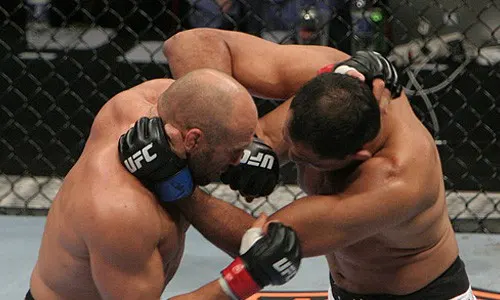
Since the dawn of civilization worldwide, humans have created numerous combat systems and tactics to survive warfare. As such, one highly controversial but effective and vicious fighting method is commonly known as “dirty fighting.”
Dirty fighting generally refers to a pure self-defense tactic that aims to quickly inflict excruciating pain on vulnerable bodily areas using any necessary means where there are no rules.
In combat sports, where fighters must adhere to the rules, dirty fighting also refers to the use of unconventional tactics or strikes. While some may view dirty fighting as nothing more than cheating and dishonorable to use in combat, some combat arts incorporate dirty fighting as a significant part of their practice.
This is a brief overview of dirty fighting. In this article, we’ll delve deeper into dirty fighting to give you a complete understanding. Furthermore, we’ll look at some different combat styles that use dirty fighting techniques. Let’s get started.
What Is Considered Dirty Fighting?
There are two major ways to define dirty fighting: without rules or with rules.
Dirty fighting without rules
The concept of dirty fighting, or “fighting dirty,” is typically associated with using any means necessary to defend oneself, such as employing vicious moves in a street fight where the end justifies the means.
For example, dirty fighting includes eye gouging, punching the throat, kicking or squeezing the groins, hair pulling, biting the attacker by the arm, kicking them while they are grounded, or using notorious headbutts. Simply put, using “barbaric” techniques to target vital organs or using non-traditional strikes that cause instant severe pain or injury is considered dirty fighting.
At the same time, the use of nearby objects to strike their assailant, such as a glass bottle or stick, is also considered a dirty fighting tactic.
So, as you can see, dirty fighting in these circumstances, without rules, is generally about unleashing your violent instincts and aggressiveness for survival.
Dirty fighting with rules
Dirty fighting, sometimes referred to as “dirty boxing,” has an entirely different meaning in combat sports, where the rules are enforced. It refers to a fighting style where a fighter schemes with the rules to gain an advantage or strikes their opponent in unconventional ways. Despite being frowned upon, some dirty moves are allowed, or maybe illegal, under certain rules.
Dirty fighting moves in combat sports generally include striking with elbows, punches, and knees while in the clinch. Also, stomping feet, using headbutts to strike the opponent’s face in a way that looks accidental, and landing illegal strikes when the referee is not looking are all part of dirty fighting.
Why Is It Called “Dirty Fighting” in Combat Sports?
Seeing someone apply unsportsmanlike techniques such as eye-gouging or pulling hair visually looks “dirty,” “nasty,” or “awful” in a street fight, which likely led to the origin of the term.
In combat sports competitions, however, there are clear rules about what types of techniques contestants are allowed to use and what they are not allowed to use. Breaking these rules and using illegal techniques can inflict serious injuries and long-term damage and, in some cases, even be lethal.
Thus, using dirty moves in combat sports is frowned upon as cheating or fighting dirty, and over time, the term “dirty fighting” has become part of the martial arts vernacular. It became a metaphor for a fighting style that doesn’t win in a fair way but cheats at the cost of seriously hurting their opponent.
RELATED: Does MMA Work In a Street Fight?
When Is It Acceptable to Fight Dirty?
When your life is in danger, fighting dirty is not considered cheating or illegal but rather a survival tactic to protect yourself or your loved ones.
When dealing with an assailant on the street, they are not bound by any rules. As a result, you, as a defender, using any necessary fighting techniques, even those considered dirty, to protect yourself is acceptable and justifiable in a court of law.
However, recognizing the fine line between defending oneself and becoming the aggressor is also crucial. If you have successfully subdued the attacker and they have surrendered, then it’s over. There is no need to resort to further violent and dirty techniques, such as delivering brutal soccer kicks to their heads while standing up or poking their eyes when it’s over.
Ironically, if you cause unnecessary physical damage to your assailant after they surrender, you could end up in legal trouble instead of being praised for protecting yourself.
What you want to avoid is severely injuring your attacker unnecessarily after you have successfully and justifiably managed to defend yourself, and it’s over, but you end up in prison when it should be the opposite.
RECOMMENDED READING: What is Gracie Jiu-Jitsu?
What Does Dirty Boxing Mean?
Dirty fighting in the striking arts is often called “dirty boxing.” Dirty boxing generally refers to using various unorthodox boxing techniques and tactics, which can sometimes be on the borderline of being illegal or downright illegal, depending on the sport, to gain an advantage in a fight.
One great example of dirty boxing is when a fighter strikes the opponent with short, rapid punches with one hand from the clinch position while holding the back of their head with the other hand to restrict their opponent’s head movement. See the below picture for a dirty boxing illustration.

Credit: mmawiki.org
More examples include when a boxer tries to gain an advantage by hitting their opponent with sneaky shoulder bumps, sucker punches, hitting the back of the head, headbutting them inside the clinch, or repeatedly pushing their opponent’s face or body with their forearms.
Many boxers frequently use these borderline illegal tactics, hoping to go unnoticed by the referee or appear unintentional in their execution. As such, dirty boxing also means manipulating the rules and getting away with illegal techniques.
So, is dirty boxing always frowned upon, then? No, it’s not. Some dirty boxing moves are legit techniques. For example, you will often see a boxer using their head and shoulders to push their opponents into a disadvantageous position during a fight, which is also described as dirty boxing technique.
What Does Fighting Dirty Mean in MMA?
Fighting “dirty” or dirty fighting is a metaphor used in MMA to describe a fighter using various unconventional but mostly legal techniques and methods to gain an advantage in a fight. As the most complex combat sport, MMA rules give athletes a lot of leeway to use various types of non-traditional techniques to make their game more rounded and unpredictable, which can sometimes be considered dirty fighting.
For example, a fighter may initiate the clinch position, where they will throw short-rapid punches while holding the opponent’s back of the head to break their posture, which is legal to do in MMA. Then, the fighter might start stomping their opponent’s feet to hurt their feet or knees to the thighs and side of the opponent’s knee to compromise their movement.
Conor McGregor famously used shoulder strikes to break Donald Cerrone’s nose at UFC 246, which is another practical dirty fighting technique.
Because MMA fighters wear open-fingered gloves, their fingers are exposed and can cause issues during a fight, unlike boxers, whose fingers are fully covered. MMA fighters risk accidentally poking their opponents in the eye or putting fingers in their mouth or nose, and these actions are considered “fighting dirty,” which is greatly frowned upon by fighters. However, if the referee determines that these actions were intentional, the fighters may face penalties or even disqualification.
During the UFC 281 fight between Michael Chandler and Dustin Poirier, Chandler attempted to lift Dustin’s head by putting his fingers in Dustin’s mouth, trying to secure a rear naked choke. Chandler was heavily criticized for fighting “dirty.”
Which Martial Arts Teach Dirty Fighting?
There are a number of martial arts around the world that teach a person how to use dirty fighting techniques effectively in combat situations. Most of these hand-to-hand combat systems were created for the military and law enforcement and later became accessible to other people.
For the purpose of this article, we have focused on the most popular ones:
Krav Maga
Krav Maga is a hybrid martial art developed by the Israeli Military in the 1950s, which later became popular worldwide for effectiveness. The system focuses solely on self-defense and preparing individuals for real-life combat situations.
There is no competition or rules of any kind, as the entire concept revolves around you using everything you can to protect yourself as fast and efficiently as possible. If that means grabbing a rock off the ground and hitting the attacker, that’s what you are trained to do.
The learning curriculum includes striking with all points of contact, wrestling, judo trips and throws, and joint locks and chokeholds from jujutsu and BJJ. It also teaches a person how to disarm the attacker and use dirty fighting techniques such as gouging eyes, fish hooking, attacking the groin area, and much more.
Students also learn what to do in different environments, maintain high awareness, assess their situation, and develop a strategy to deal with a violent situation in a split second.
Although all these may sound brutal at first glance, they’re what make Krav Maga so effective and popular worldwide.
Lethwei
Lethwei is a combat sport from Myanmar that is also known as Burmese boxing. Lethwei fighters can fight at all ranges, including the clinch, from which they often throw each other with trips and throws, but are not allowed to strike the grounded opponent.
People within the martial arts community often describe Lethwei as a more brutal variation of Muay Thai. The two systems share very much the same techniques regarding striking, standup grappling, and rules of competition. But what makes them different is the fact that Lethwei adds dirty fighting techniques on top of this.
Lethwei, known as the “Art of Nine Limbs,” incorporates a unique and controversial dirty fighting technique – headbutts. While banned in many other combat sports, headbutts are a crucial technique in Lethwei fighting, which also involves the use of fists, elbows, kicks, and knees.
Watching Lethwei matches, you can often see fighters breaking their opponents’ noses or knocking them out cold with headbutts. On top of that, contestants do not wear padded gloves as they compete bare-knuckle.
This mix of bare-knuckle striking and infamous headbutts gave Lethwei a reputation for being one of the most brutal and dirtiest combat sports.
Wing Chun
Wing Chun is one of the most popular Chinese martial arts styles, designed for close-range combat and heavily reliant on dirty fighting tactics to target soft tissue areas in humans. This art focuses on striking areas such as the eyes, throat, groin, and cheeks, with the goal of incapacitating the opponent quickly and effectively.
Wing Chun teaches you to deliver fast and precise strikes to the attackers’ vital points down the center of their bodies, such as the neck, chest, belly, kidney, or groin. The point is to execute strikes in a relaxed manner and use the attacker’s momentum against them to generate force and do damage.
The system focuses on economic movement, intercepting the opponent’s attacks with blocks and rapid punching and kicking.
Combat Sambo
Combat Sambo is a Russian military combat system developed in the 1920s. But in modern times, combat sambo is being taught to anyone who wants to learn self-defense. There is also a sport variation called sport sambo, where they can put their skills to the test against other practitioners.
As a concept, Sambo resembles modern MMA fighting to a large degree because it is also a hybrid mix of striking, grappling, and ground fighting. The military version of combat sambo includes weapon-based training where practitioners learn to defend against various weapons and firearms. It also teaches dirty fighting techniques for close-range combat, making it comparable to Krav Maga.
Dirty fighting techniques include pressure-point attacks, targeting vital organs, eye-gouging, striking the throat, and even how to use grappling moves in a “dirty” way. Instructors teach joint locks and submissions for combat purposes, which are more violent than regular BJJ classes.
In combat sambo, throwing a strike means aiming to knock out the opponent, while going for a takedown means slamming them to the ground with great force. These full-force attacks can be viewed as dirty fighting, but the core objective is to execute each move with maximum force and defeat the opponent as quickly as possible.
Among many other reasons, this is why sambo fighters in MMA, like Khabib Nurmagomedov and Fedor Emelianenko, were so explosive and aggressive compared to other fighters because they were trained to be very aggressive.
Jujutsu (Traditional Japanese Jiu-Jitsu)
Japanese Jujutsu is one of the most influential martial arts and a precursor to many other martial arts, such as Judo and different styles of Jiu-Jitsu. Jujutsu was practiced by the Samurai warriors, who used the art on the battlefield during the feudal period.
The system was designed to cover all the elements of fighting in warfare by teaching you how to neutralize the enemy in the most efficient way possible.
Apart from conventional techniques such as punches and kicks, joint locks, and takedowns, Jujutsu teaches how to break bones and necks or use other dirty fighting methods such as eye gouges to cause as much pain and damage as possible.
Jujutsu also taught samurai to quickly dispatch their enemies using swords and even using the enemy’s weapon against them.
